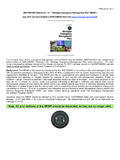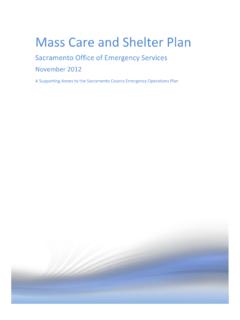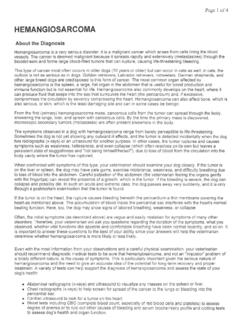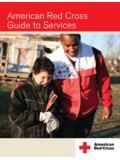Transcription of Ten Urgent Care Innovations Alan A. Ayers, MBA, …
1 Ten Urgent care Innovations Alan A. Ayers, MBA, MAcc content advisor , Urgent care association of america Vice President of Strategy and Execution, Concentra Urgent care Entrepreneurism is the breeding ground of innovation. When a vested business owner is free to develop solutions that meet consumer needs better than alternatives, new delivery models, technology, and processes result improving quality, increasing access, and lowering costs. Urgent care is entrepreneurial medicine health care delivered through highly visible locations where consumers live and work, extended evening and weekend hours, and walk-in service with short wait times. Therefore, it's no surprise that Urgent care operators are refining their practices to better meet consumer needs, as demonstrated by the following ten Innovations : 1. Web Check-in When a new patient presents at an Urgent care center, typically that patient writes his or her demographics, health history, and insurance information on a paper form.
2 The patient then waits while the front office staff types the data into the practice management system and contacts the insurance company to verify coverage and assess financial responsibility. Because wait times are directly correlated to patient satisfaction, bottlenecks at the front office can lead to unhappy patients leaving the center prior to being served. By contrast, patients using an Urgent care center's web check-in feature enter their own demographics over the Internet, thus eliminating the time and error of front office re-entry. Insurance verification may be electronic or through a centralized support function, providing an opportunity to set patient expectations for payment. Although some centers use web check-in to schedule appointments at set times, a common model is to call the patient 10-15 minutes prior to the physician being ready to see them. Ideally, the patient arrives, signs any authorizations, pays his/her financial responsibility, and goes straight to the exam room.
3 The ability to prioritize patients based on symptoms improves flow, increases staff efficiencies, and maximizes facility utilization. While two or three hour waits would normally be intolerable in an Urgent care waiting room, patients who have checked-in online may be perfectly satisfied waiting at home or work provided they are treated quickly once they arrive at the center. 2. Check-in Kiosk In recent years, self-service kiosks have become commonplace at airports, banks, and retail stores because they shift non-value-added transaction and administrative tasks from paid employees to consumers. Not only are consumers becoming increasingly comfortable with self-service technologies, many people feel empowered by their ability to assure a transaction is completed correctly. Like web check-in, patients use a check-in kiosk to enter their demographic and insurance information, make any required payments, and sign authorizations using an electronic signature pad.
4 Freed from the burden of manual data entry, the center staff can better serve patients. A kiosk with electronic signature capabilities also reduces the overhead of processing and storing paper. For ideas on how to improve the efficiency of your front office, see The Front Office: Window to Your Practice in the November, 2008 Journal of Urgent care Medicine at 3. Wait Times Published on Website Patients want to know what to expect before visiting an Urgent care center so being able to check anticipated wait times gives patients the option to wait for a non-peak time or go to a facility with shorter waits. In a citywide network of Urgent care centers, it's not atypical for one center to have waits exceeding 90 minutes while an affiliated center five miles away has zero wait. In exchange for 10-15 minutes in the car, patients could be seen immediately. But not knowing the wait time at each center or assuming all centers are busy patients continue to wait at the busiest centers.
5 Posting wait times online levels volume across centers, reduces congestion at busy centers, and holds staff accountable for reducing waits. The downside is that volume and wait times constantly change in a walk-in facility and long posted wait times may deter patients from Urgent care altogether. For ideas on increasing visibility and functionality of your website, see Creating a Web Presence for Urgent care in the July/August, 2009 Journal of Urgent care Medicine at #/887494ea/1. 4. Patient Status Board Complaints about waiting in an Urgent care center often aren't about the wait itself, but rather, lack of communication. The suspense of not knowing where a patient is in the queue causes angst, especially when waiting patients see new arrivals taken back to the treatment area more quickly patients don't know who's there for physician and non- physician services. By contrast, frequent communication of the patient's place in line and anticipated remaining wait reduces uncertainty (and the likelihood the patient will balk).
6 One Urgent care operator's solution to the communication challenge is an electronic patient status board each patient is assigned an anonymous code which posts their place in line on an LCD screen according to the type of service (such as lab, Urgent care or occ med). Patients can see their position relative to other patients, see how long each patient has been waiting, and gain a clear understanding as to how quickly patients are flowing through the center. For ideas on managing wait times, see Managing Wait Times for Greater Customer Satisfaction in the September, 2008. Journal of Urgent care Medicine at 5. Transportation Service Where an Urgent care center serves patients without cars such as tourists in a resort area providing transportation to the center can be a marketing differentiator. For example, a center positioned in a mass of convention hotels may develop relationships with hotel concierges to pick up, treat, and return guests who become sick or injured.
7 Likewise, Urgent care centers offering occupational medicine services can add value to local employers by picking up patients requiring physicals or injury care particularly where employees normally rely on bus or train transportation. Patients not returning for pre-authorized care leads to foregone revenue so picking up patients for scheduled re-checks or physical therapy can increase compliance with treatment regimens and reduce the likelihood of appointment no-shows. Alternatively, where visit lift doesn't justify direct investment in a van, insurance, and driver's time, an Urgent care center may contract with a local taxi company to bill the center for patients brought in for care . Aware that trips to the Urgent care center generate cab fares, taxi drivers start to spread word-of-mouth about the center, bringing in non- acute patients who might otherwise have used an emergency room. 6. Occupational Medicine Online Reporting When a workplace injury occurs, an employer needs timely information to get the employee back to work quickly and safely.
8 In response, some Urgent care centers communicate with employers through automatic emails or an online portal that provides the patient's diagnosis and work status, case history and costs, and appointment listing. When combined with a record archive, employers may review historic utilization, research specific cases, or retrieve copies of common documents (such as a chain of custody or DOT card). In addition, the ability for employers to update protocols, contact information, and billing details can reduce errors in service delivery and improve payment speed. Examples of online occupational medicine reporting include: State Workers' Compensation forms (such as first report of injury, medical treatment and work status). Online drug screen results (may also apply to BAT, TB, PFT, audiogram and performance evaluations). DOT cards and/or reports of physical examination Related is an electronic authorization to treat. Like web registration for consumers, employers enter patient demographics, specify and pay for services, and even schedule appointments online.
9 Electronic authorizations reduce front office time in contacting employers with questions, prevent lost or illegible authorizations, and provide a forecast of expected occ med patients for the day. 7. Online Bill Payment One reason medical bills often don't get paid right away is the time it takes for consumers to write a paper check, address an envelope, secure a postage stamp, and drop the payment in the mail. Consumers are now acclimated to paying credit card, utility and even tax bills online and many fears about security and privacy of Internet transactions have subsided. Regardless of whether a patient receives a paper statement or can access his/her billing information online, the ability to pay online using a credit card or electronic check can improve collections rates and reduce accounts receivable days. An online bill pay interface may be as simple as the consumer entering the account or invoice number, the payment amount, and the payment mechanism, which is transmitted in a secure environment to the Urgent care center's billing office and processed as any other payment received by telephone or mail.
10 More sophisticated applications integrate with billing systems and post payments without any manual intervention. 8. Posted Pricing Nationally over 46 million people are without health insurance and millions more are migrating to high-deductible health plans that make them responsible for routine health care expenses. Many of the uninsured are self-employed, work for small businesses, work one or more part-time jobs, or are in their early 20s and not yet established in the workforce. In some communities with a service economy and immigrant populations, the percentage of uninsured can be 50 percent or higher. When inquiring of Urgent care centers about their price, common responses include, it starts at $95 and goes up to $250, it depends on what the doctor finds, or the cost is determined by our billing company. Each response creates a blind transaction. Just as few people would feel comfortable eating at a restaurant with no prices on the menu, when patients don't know the cost of medical care , they're likely to forego care sometimes resulting in a minor condition turning into an emergency episode.







